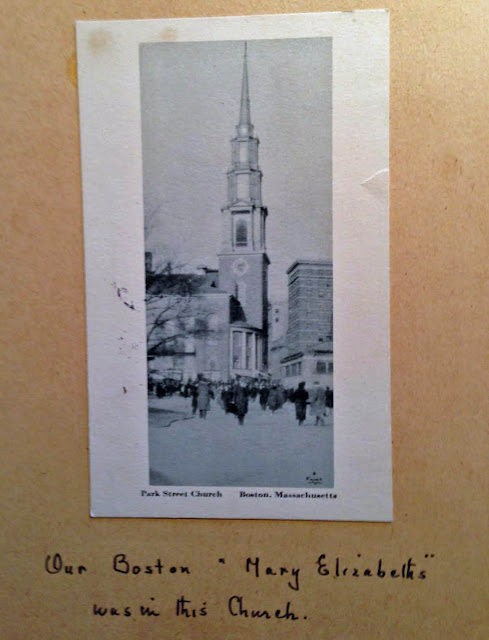The main eatery at Brown University is affectionately known as "the Ratty," but its official name is the Sharpe Refectory Dining Hall, named for Chancellor Henry Dexter Sharpe 1894.
During my time at Brown in the 1970s, the portrait of a mysterious woman hung on one of the walls of the Ratty. It would be forty years--and the writing of Innovation on Tap--before I came to know the name and story of this enigmatic lady.
Mary Elizabeth Evans married Henry Sharpe in 1920. Her incredible entrepreneurial story--from making candy in her family's kitchen in Syracuse to running a large-scale confectionery and hospitality organization throughout the East--is featured in chapter 5 of my book (excerpted below). But it also seems appropriate on this Earth Day 2020 to remember her other gifts.
At the invitation of Brown's President Henry Wriston (1937-1955), Sharpe became the University's unofficial, enormously talented landscape architect. She is responsible for the design and planting of many of the trees that still beautify the Brown campus. Mary Elizabeth was also instrumental in the creation of the Japanese Gardens at Roger Williams Park. And her pledge of more than $150,000 in 1970--along with her historical research and "determined efforts"--helped to reclaim and beautify Providence's India Point Park. Were she alive today, she would surely be celebrating Earth Day with us.
Another of her legacies is the beautiful Rochambeau House and Gardens that she and Henry built on the East Side of Providence. Today it is the home of Brown's French Studies.
Mary Elizabeth lived to see her 100th birthday in 1985 and recorded her life's story a few years earlier for the Schlesinger Library at Radcliffe, which made her incredible interview available to me.
Onondaga Historical Association, who treated me to my first Mary Elizabeth chocolate (made by his organization from one of her original recipes). Mary Elizabeth's son and daughter-in-law, Henry Jr and Peggy, have also been gracious with their time and support--and their willingness to share these wonderful images.
 |
| The "Mary Elizabeth" logo |
+++++++++++++++++++
“We began to be limited with
sugar, and in a very direct sort of way I decided I would go down to Washington
and talk to Mr. Hoover [Herbert Hoover, head of the US Food
Administration during World War I] and ask him what this really meant for
people like us,” Mary Elizabeth recalled.
 |
| Some of Mary Elizabeth's storefronts in New York City. A note reads: "chairs borrowed from local undertaker, hoping that no funeral occurred. . . ." |
"I don't know why it is with me, but I always
have the instinct to do. Go to the top . . . Well, anyway, I managed to get an
appointment with him. We were supposed to save wheat and beef and sugar and
they were to be rationed. I told him that I had this $50,000 a year lease and I
had just begun to get established, but I didn't come down to plead for any
extra. I said, "I want suggestions. What can I do? Can I make candy out of
honey? Is honey going to be on the list? Are dried fruits and nuts and things
like that going to be available?" And I said, "I sell cakes, and I
sell tea. If I can't have flour, can I use rice flour or other things of that
kind?"
Hoover was impressed, saying, “You’re the only
person who has come down here with any constructive ideas. I will see to it
that you get your full allotment.”
 |
| Patrons at a Mary Elizabeth Tea Room |
But Evans knew that allotments and actual
deliveries were two different things, so she experimented with recipes that
used the raw materials at hand, and when successful, gave them to customers and
friends. “So I got a big editorial in the
New York Times on having done this. Without seeking it . . . That, of
course, gave extra publicity and extra income as well.”
 |
| One of two Mary Elizabeth tea rooms in Boston was located in the basement of the Park Street Church |
In the summer of 1918, Hoover sent Evans to Paris to oversee
the US Central Diet Kitchen. Full of energy and ideas, she published two books
during the war, one that explained her candy-making techniques, and one with a
collection of wartime recipes that became so popular it was reprinted during World
War II to help homemakers faced with rationing. Her gift for “making do,” which
had served her family so well, was now obvious to the general public. . . .
 |
| Mary Elizabeth and team at the Red Cross Diet Kitchen in Paris, 1918 |
+++++++++++++++++++++++
This is the eighth excerpt from Innovation on Tap: Stories of Entrepreneurship From the Cotton Gin to Broadway's "Hamilton" © Eric B. Schultz, available on Amazon, Barnes & Noble, and in quantity from Baker & Taylor or Greenleaf Book Group at 800-932-5420.
 Excerpt #1, about Buddy Bolden and the birth of jazz, is here. Excerpt #2, about Jason Jacobs and the growth of Runkeeper, is here. Excerpt #3, about Jean Brownhill and Sweeten, is here. Excerpt #4, about Elizabeth Arden and "the right to be beautiful," is here. Excerpt #5, about GM's Alfred Sloan (the most successful American entrepreneur ever?), is here. Excerpt #6, about Evertrue’s Brent Grinna, is here. Excerpt #7, about Lin-Manuel Miranda and Hamilton, is here.
Excerpt #1, about Buddy Bolden and the birth of jazz, is here. Excerpt #2, about Jason Jacobs and the growth of Runkeeper, is here. Excerpt #3, about Jean Brownhill and Sweeten, is here. Excerpt #4, about Elizabeth Arden and "the right to be beautiful," is here. Excerpt #5, about GM's Alfred Sloan (the most successful American entrepreneur ever?), is here. Excerpt #6, about Evertrue’s Brent Grinna, is here. Excerpt #7, about Lin-Manuel Miranda and Hamilton, is here.


No comments:
Post a Comment